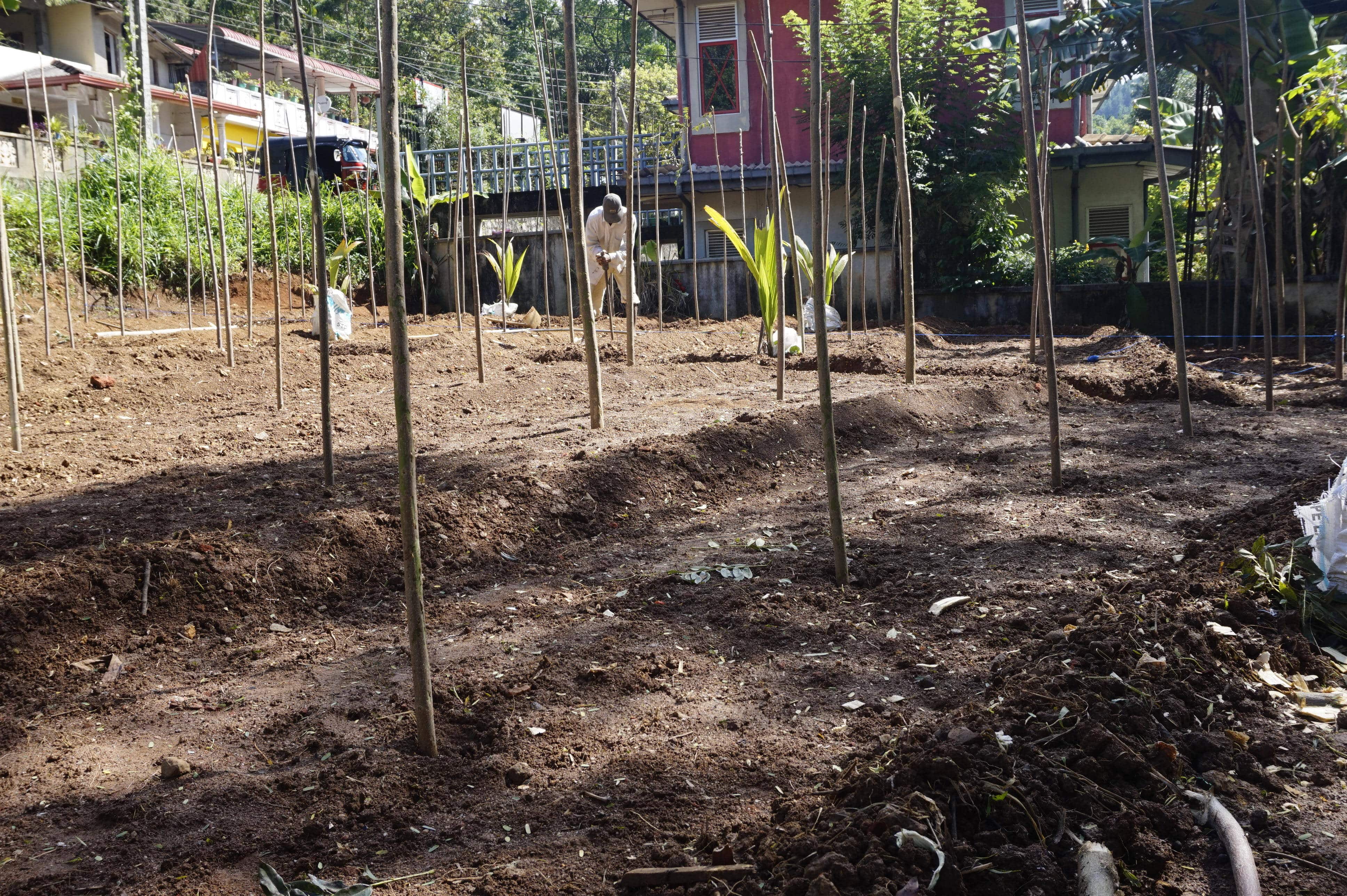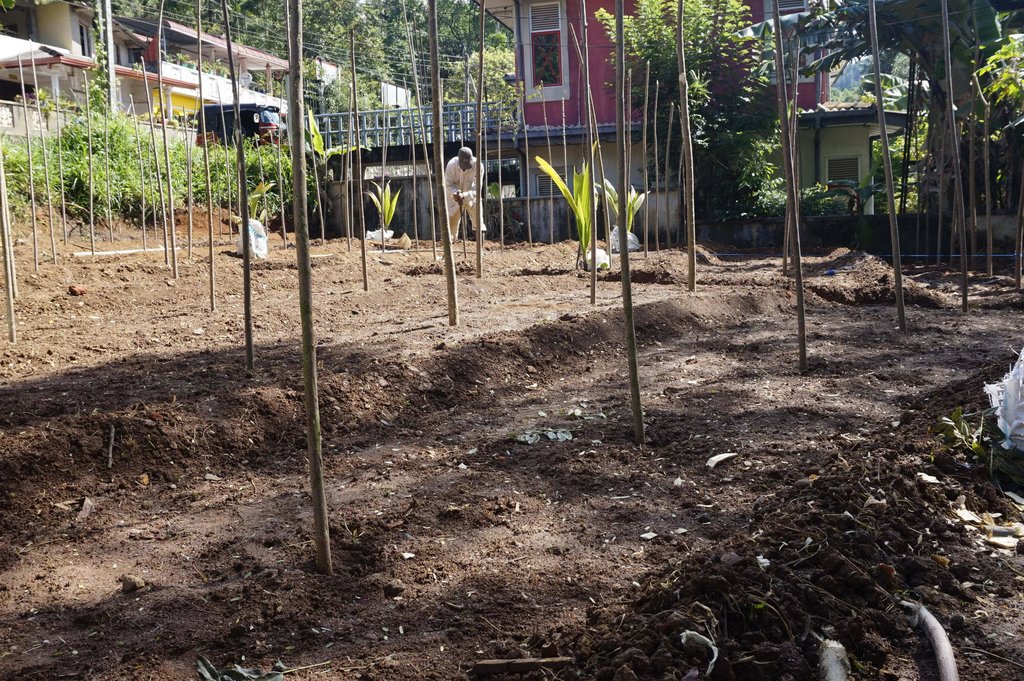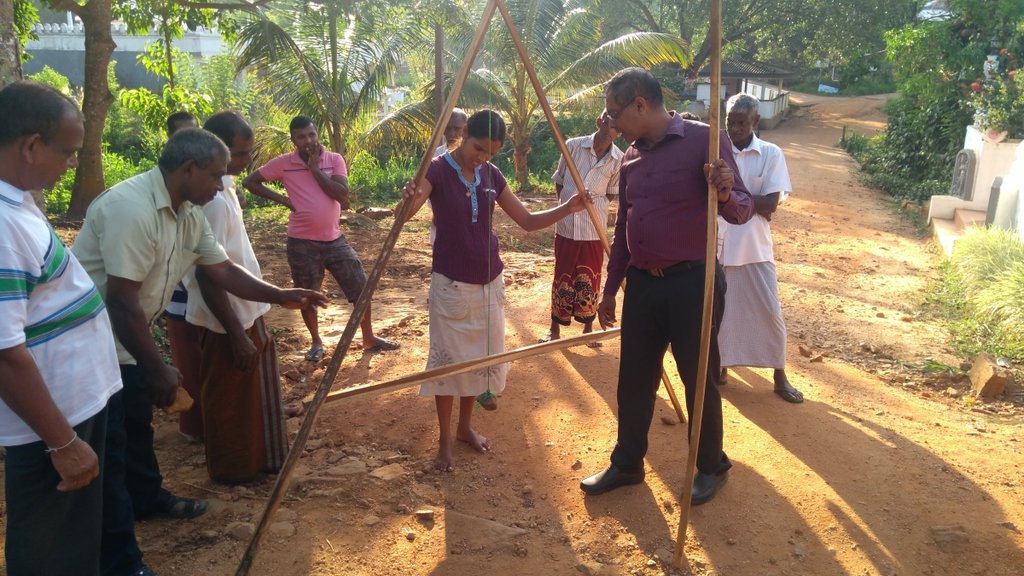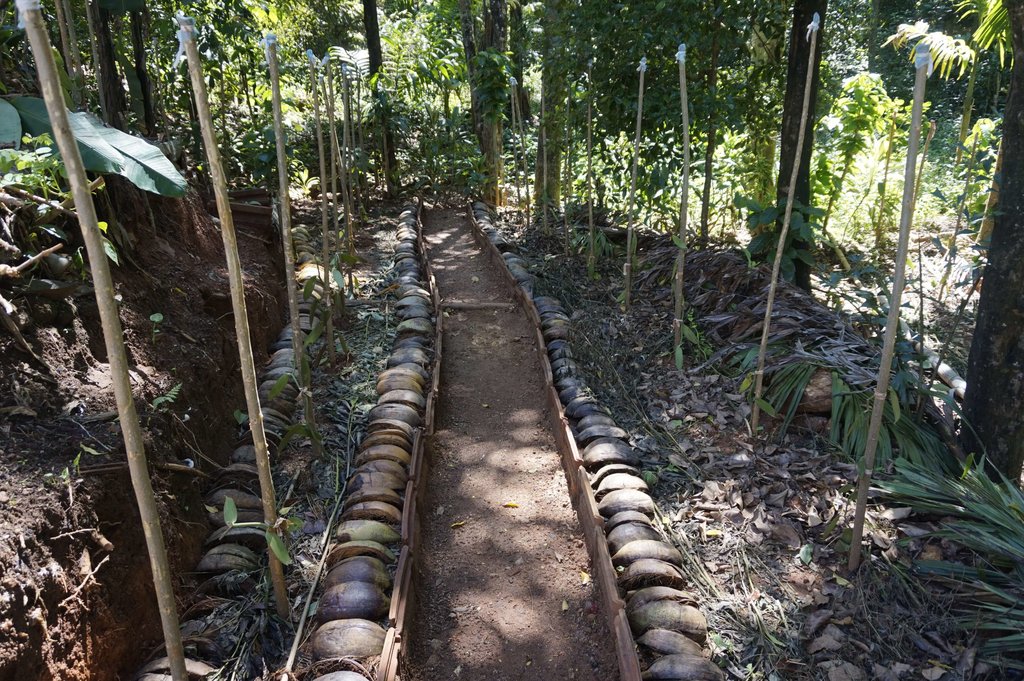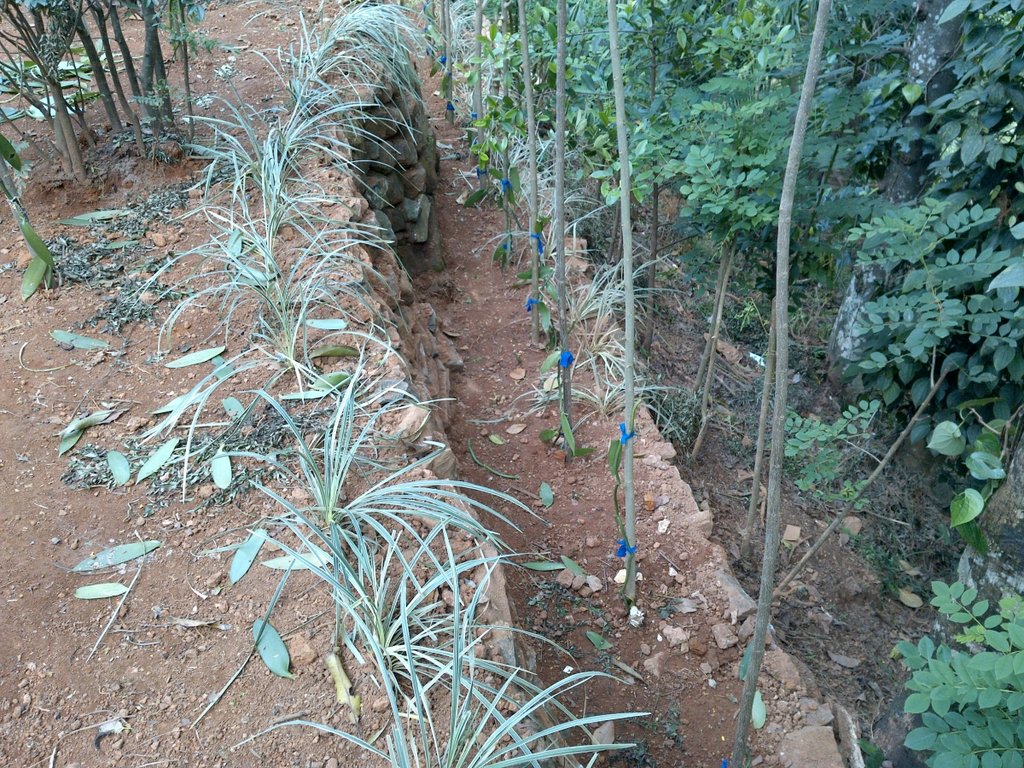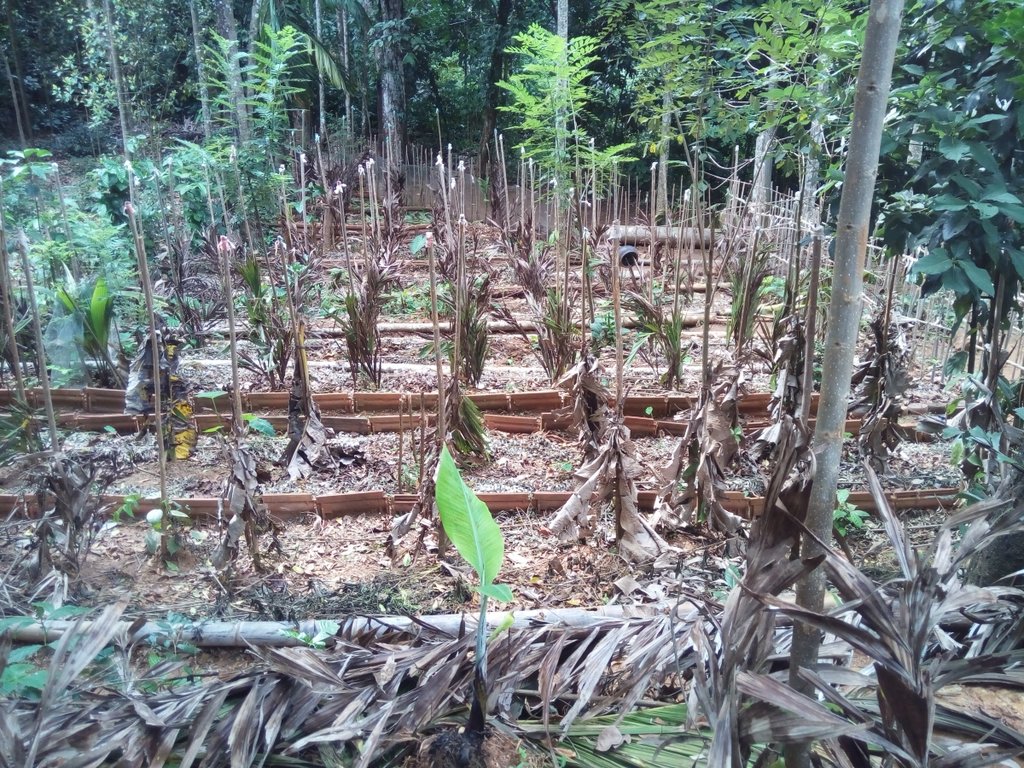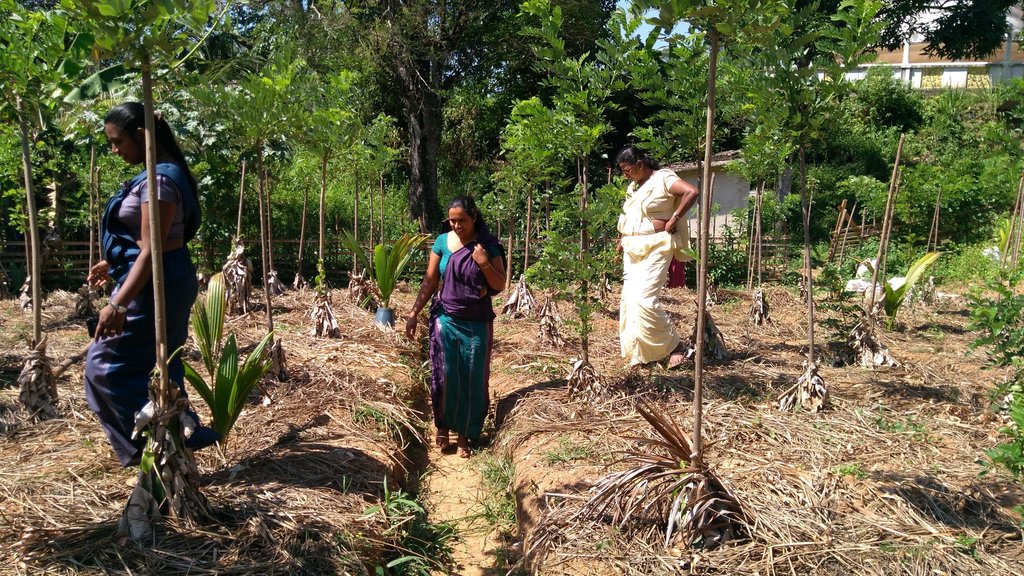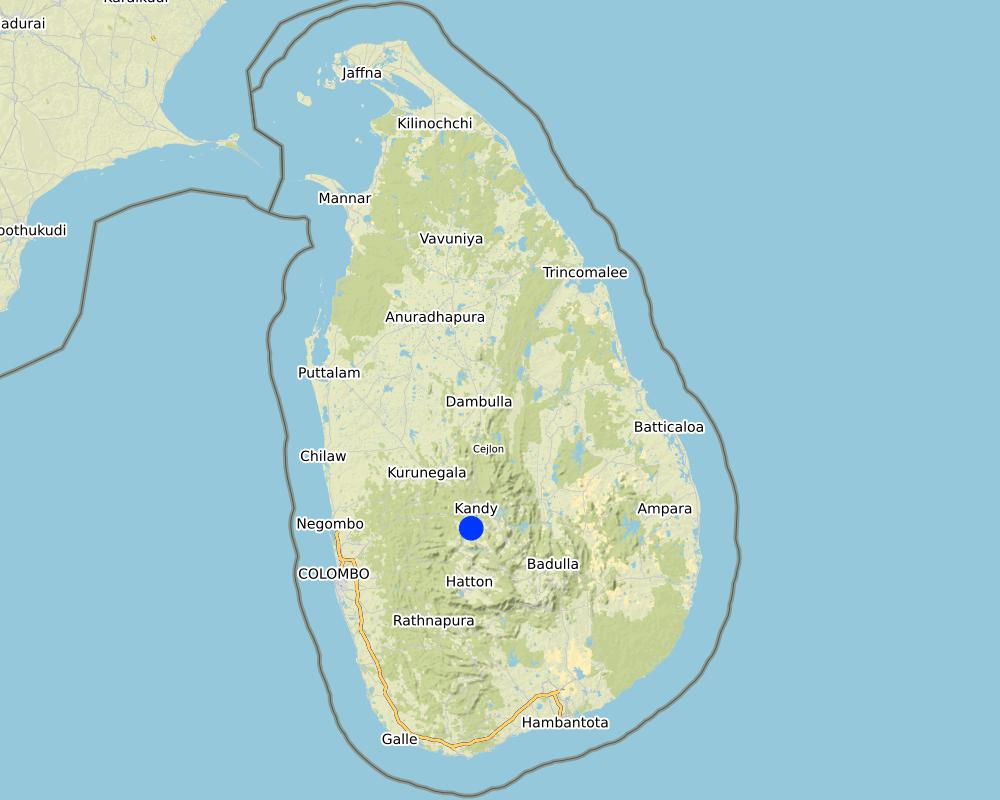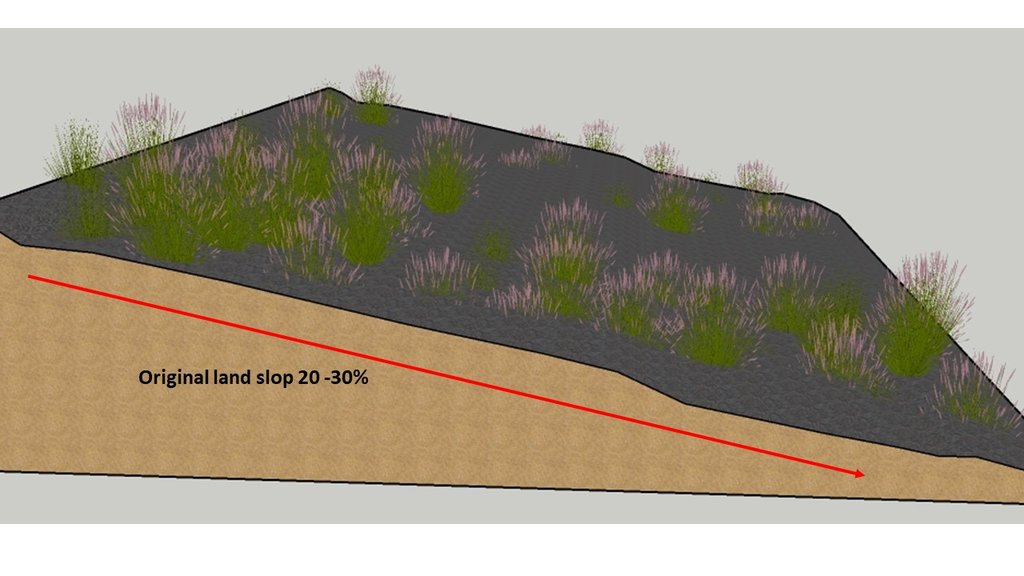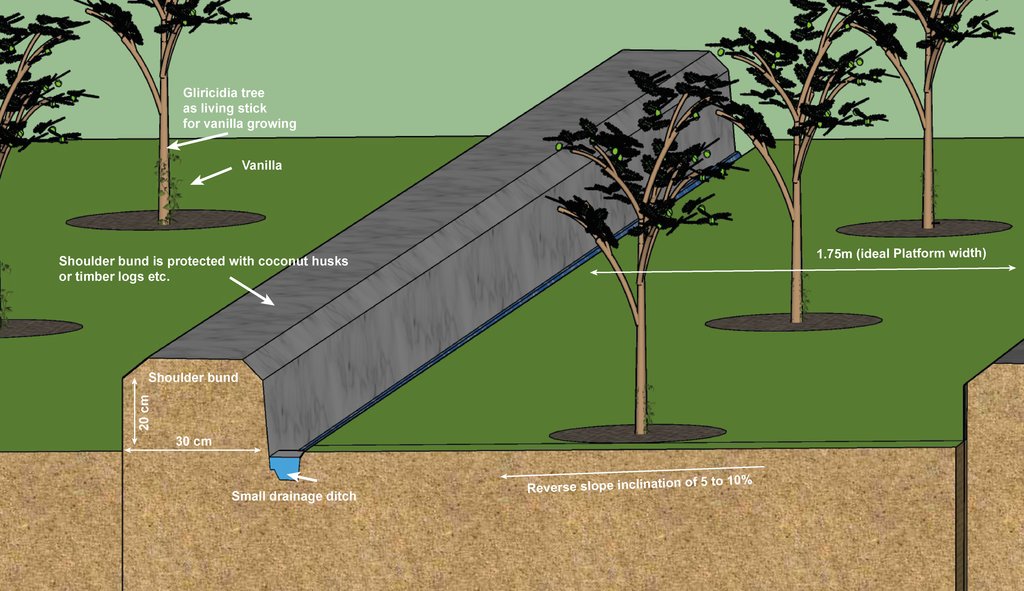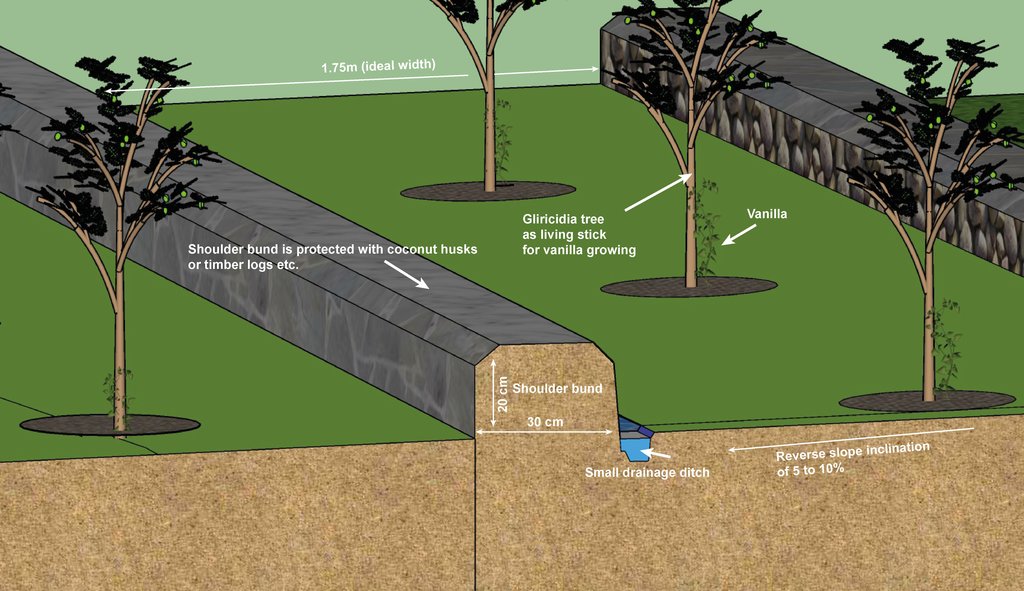Individual platforms and contour platforms [ศรีลังกา]
- ผู้สร้างสรรค์:
- การอัพเดท:
- ผู้รวบรวม: Bandara Rotawewa
- ผู้เรียบเรียง: –
- ผู้ตรวจสอบ: Ursula Gaemperli, Rima Mekdaschi Studer
Thani wedika and samochcha wedika
technologies_5621 - ศรีลังกา
ดูส่วนย่อย
ขยายทั้งหมด ย่อทั้งหมด1. ข้อมูลทั่วไป
1.2 รายละเอียดที่ติดต่อได้ของผู้รวบรวมและองค์กรที่เกี่ยวข้องในการประเมินและการจัดเตรียมทำเอกสารของเทคโนโลยี
ชื่อของโครงการซึ่งอำนวยความสะดวกในการทำเอกสารหรือการประเมินเทคโนโลยี (ถ้าเกี่ยวข้อง)
Rehabilitation of Degraded Agricultural Lands in Kandy, Badulla and Nuwara Eliya Districts in the Central Highlands of Sri Lanka1.3 เงื่อนไขการใช้ข้อมูลที่ได้บันทึกผ่านทาง WOCAT
ผู้รวบรวมและวิทยากรหลักยอมรับเงื่อนไขเกี่ยวกับการใช้ข้อมูลที่ถูกบันทึกผ่านทาง WOCAT:
ใช่
1.4 การเปิดเผยเรื่องความยั่งยืนของเทคโนโลยีที่ได้อธิบายไว้
เทคโนโลยีที่ได้อธิบายไว้นี้เป็นปัญหาของความเสื่อมโทรมโทรมของที่ดินหรือไม่ จึงไม่ได้รับการยอมรับว่าเป็นเทคโนโลยีเพื่อการจัดการที่ดินอย่างยั่งยืน:
ไม่ใช่
1.5 Reference to Questionnaire(s) on SLM Approaches (documented using WOCAT)
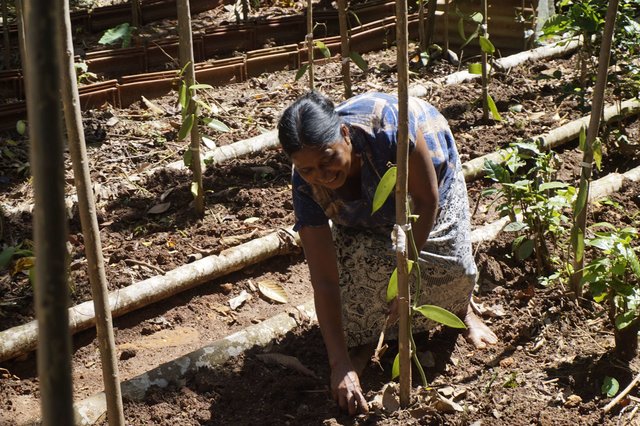
Women practices SLM through Vanilla cultivation [ศรีลังกา]
Women in Central Highlands of Sri Lanka practice sustainable land management through vanilla cultivation and earn extra income for their families
- ผู้รวบรวม: Bandara Rotawewa
2. การอธิบายลักษณะของเทคโนโลยี SLM
2.1 การอธิบายแบบสั้น ๆ ของเทคโนโลยี
คำจำกัดความของเทคโนโลยี:
Construction of individual platforms or contour platforms to control soil erosion in the home gardens (HG) to cultivate vanilla as a cash crop
2.2 การอธิบายแบบละเอียดของเทคโนโลยี
คำอธิบาย:
Doluwa is located in the Central Highlands of Sri Lanka. This area belongs to the Wet zone mid-country agro-ecological region according to Sri Lankan classification. The elevation of the area is 575 meters. The mean temperature of the area is about 24 °C. The area receives rainfall from two monsoons. North-east monsoon rain comes from November to January with an annual rainfall of 1800 mm. The South-west monsoon rain lasts from May to September and contributes a major portion of the annual rainfall. February, March, and July months receive lower rainfall. The Central Highlands have excellent agro-ecological conditions for tea plantations, spice crops like cloves, nutmeg and cardamom, fruit crops such as avocado, durian, coffee, banana, and black pepper. Paddy cultivation is practiced in the valleys. Areas over 50% of slope inclination are covered by protected forests. The main livelihood activity is agriculture: mainly cultivation of tea, spices, and vegetables. About 43% of the land is under tea cultivation; and around 15% is marginalized or abandoned land, due to land degradation and low productivity of soils.
The average land size of home gardens in the Central Highlands of Sri Lanka is about 0.25 – 0.5 acres. Fruits and spice trees randomly exist in these land plots. The topsoil is always disturbed due to daily human activities. Apart from run-off water from upper lands, rooftop rainwater flows in all directions causing heavy soil erosion in these home gardens. The home gardens are the least attended land plots in terms of conservation due to low-income generation.
Traditionally, home gardens with randomly planted perennial trees are usually shady. Therefore, farm families generally believe that cultivation of cash crops in their home gardens is impossible. The introduction of Individual Platforms and Contour Platforms as a soil conservation methodology, piloted in the Doluwa area by an FAO project on Rehabilitation of Degraded Agricultural in several Districts of the Central Highlands of Sri Lanka has proven the contrary, as mainly vanilla is known as a shade-preferring crop. Furhter, vanilla is economically highly valuable and has the potential to generate good income. Consequently, adequate platforms (small soil terraces) were constructed and used for vanilla cultivation. Vanilla grows particularly well where the soil organic matter content is high. Organic matter required to enrich the soil can be collected directly from the home gardens (leaves and residues) and is also coming from organic kitchen waste. These organic residues are recycled into compost and finally used for the cultivation of vanilla. Additionally, mulching is practiced to control topsoil erosion. Each vanilla plant as a tropical climbing vine grows up a previously planted two-meter-high Gliricidia stick. Gliricidia serves on the one hand as a living fixing stick and provider of shade and, as a leguminous tree (Fabaceae family) the plant has the potential to fix nitrogen in the soil.
Construction of the platforms:
The individual platforms are constructed around the planting hole and are one meter wide and two meters in length. The distance between the two platforms is the same (minimum 2 meters) as the space for the vanilla plant. The lower side of the platform (lower edge) has a shoulder bund, stabilized with coconut husk, tree logs, and stones.
The contour platforms are 1.75 meters in width and length depending on the land size and other characteristics. The platform is constructed with a slightly inverted gradient. A small drain with a suitable gradient along the length on the upper side of the platform is constructed to drain out excess water during rain. These small drains are connected to a leader drain. The edges of the platforms are well stabilized again by coconut husk, tree logs or stones (shoulder bund measure: height x width = 20cm x 30cm).
This sustainable land management (SLM) technology is highly accepted by the farm families, as the Vanilla SLM model is an economically attractive opportunity especially for women; but only where the environmental conditions are suitable for vanilla growing.
2.3 รูปภาพของเทคโนโลยี
2.5 ประเทศภูมิภาค หรือสถานที่ตั้งที่เทคโนโลยีได้นำไปใช้และได้รับการครอบคลุมโดยการประเมินนี้
ประเทศ:
ศรีลังกา
ภูมิภาค/รัฐ/จังหวัด:
Central
ข้อมูลจำเพาะเพิ่มเติมของสถานที่ตั้ง :
Doluwa
ระบุการกระจายตัวของเทคโนโลยี:
- ใช้ ณ จุดที่เฉพาะเจาะจงหรือเน้นไปยังบริเวณพื้นที่ขนาดเล็ก
Is/are the technology site(s) located in a permanently protected area?
ไม่ใช่
Map
×2.6 วันที่การดำเนินการ
ระบุปีที่ใช้:
2018
ถ้าไม่รู้ปีที่แน่นอน ให้ระบุวันที่โดยประมาณ:
- น้อยกว่า 10 ปี (ไม่นานนี้)
2.7 คำแนะนำของเทคโนโลยี
ให้ระบุว่าเทคโนโลยีถูกแนะนำเข้ามาอย่างไร:
- ทางโครงการหรือจากภายนอก
ความคิดเห็น (ประเภทของโครงการ เป็นต้น) :
Rehabilitation of Degraded Agricultural Lands in Kandy, Badulla and Nuwara Eliya Districts in the Central Highlands of Sri Lanka
3. การจัดประเภทของเทคโนโลยี SLM
3.1 วัตถุประสงค์หลักของเทคโนโลยี
- ปรับปรุงการผลิตให้ดีขึ้น
- ลด ป้องกัน ฟื้นฟู การเสื่อมโทรมของที่ดิน
- ป้องกันพื้นที่ลุ่มน้ำ/บริเวณท้ายน้ำ โดยร่วมกับเทคโนโลยีอื่นๆ
- สร้างผลกระทบทางด้านเศรษฐกิจที่เป็นประโยชน์
3.2 ประเภทของการใช้ที่ดินในปัจจุบันที่ได้นำเทคโนโลยีไปใช้
Land use mixed within the same land unit:
ใช่
Specify mixed land use (crops/ grazing/ trees):
- วนเกษตร (Agroforestry)

พื้นที่ปลูกพืช
- การปลูกพืชล้มลุกอายุปีเดียว
- การปลูกไม้ยืนต้น ไม้พุ่ม
- Vanilla
แสดงความคิดเห็น:
Crop types commonly found in these home gardens are cloves, nutmeg and cardamom, fruit crops of avocado, durian, coffee, banana, and black pepper
3.3 Has land use changed due to the implementation of the Technology?
Land use mixed within the same land unit:
ไม่ใช่
3.4 การใช้น้ำ
การใช้น้ำของที่ดินที่มีการใช้เทคโนโลยีอยู่:
- จากน้ำฝน
3.5 กลุ่ม SLM ที่ตรงกับเทคโนโลยีนี้
- มาตรการปลูกพืชขวางความลาดชัน (cross-slope measure)
- สวนครัว
3.6 มาตรการ SLM ที่ประกอบกันเป็นเทคโนโลยี

มาตรการจัดการพืช
- A2: อินทรียวัตถุในดิน/ความอุดมสมบูรณ์ในดิน

มาตรการอนุรักษ์ด้วยโครงสร้าง
- S1: คันดิน
3.7 รูปแบบหลักของการเสื่อมโทรมของที่ดินที่ได้รับการแก้ไขโดยเทคโนโลยี

การกัดกร่อนของดินโดยน้ำ
- Wt (Loss of topsoil): การสูญเสียดินชั้นบนหรือการกัดกร่อนที่ผิวดิน
- Wg (Gully erosion): การกัดกร่อนแบบร่องธารหรือการทำให้เกิดร่องน้ำเซาะ
3.8 การป้องกัน การลดลง หรือการฟื้นฟูความเสื่อมโทรมของที่ดิน
ระบุเป้าหมายของเทคโนโลยีกับความเสื่อมโทรมของที่ดิน:
- ป้องกันความเสื่อมโทรมของที่ดิน
- ลดความเสื่อมโทรมของดิน
4. ข้อมูลจำเพาะด้านเทคนิค กิจกรรมการนำไปปฏิบัติใช้ ปัจจัยนำเข้า และค่าใช้จ่าย
4.1 แบบแปลนทางเทคนิคของเทคโนโลยี
ข้อมูลจำเพาะด้านเทคนิค (แบบแปลนทางเทคนิคของเทคโนโลยี):
Slope gradient in home gardens before introduction of the SLM Technology.
ผู้เขียน:
Bandara Rotawewa
วันที่:
05/04/2020
ข้อมูลจำเพาะด้านเทคนิค (แบบแปลนทางเทคนิคของเทคโนโลยี):
Contour platforms: the ideal platform is 175 cm wide. The length is depending on the available length of the land. The platform is constructed by cutting the upper section and fill in to the lower section to get an inverse slope of 5 to 10%. The shoulder bund is 30 cm wide and 20 cm height. The shoulder bund is protected with coconut husk/ timber logs etc.
Individual platform: The spacing between the two plants in the platforms is 1 - 1.5 meters. The individual platform size can be 100 cm wide and 200 cm in length. Coconut husks, stones, timber logs can be used to protect the edges of the platform.
ผู้เขียน:
Bandara Rotawewa
วันที่:
05/04/2020
ข้อมูลจำเพาะด้านเทคนิค (แบบแปลนทางเทคนิคของเทคโนโลยี):
Technical description: dito drawing 2.
ผู้เขียน:
Bandara Rotawewa
วันที่:
05/04/2020
4.2 ข้อมูลทั่วไปเกี่ยวกับการคำนวณปัจจัยนำเข้าและค่าใช้จ่าย
ให้ระบุว่าค่าใช้จ่ายและปัจจัยนำเข้าได้รับการคำนวณอย่างไร:
- ต่อพื้นที่ที่ใช้เทคโนโลยี
ระบุขนาดและหน่วยพื้นที่:
0.25 acre
ระบุสกุลเงินที่ใช้คำนวณค่าใช้จ่าย:
- USD
ระบุค่าเฉลี่ยของค่าจ้างในการจ้างแรงงานต่อวัน:
840 USD per 1/4 acre of land
4.3 กิจกรรมเพื่อการจัดตั้ง
| กิจกรรม | Timing (season) | |
|---|---|---|
| 1. | Construction of contour or individual platform terraces | Before establishment of the crop |
| 2. | Reinforcement of the shoulder bunds with coconut husk/ tree logs/ etc | After construction of contour platform or individual platforms |
| 3. | Preparing of compost and mixing it into the top soil | Before establishment of the crop |
| 4. | Planting of vanilla rooted cutting | First Live Gliricidia sticks are planted. After they rooted, vanilla cuttings are planted) |
4.4 ค่าใช้จ่ายของปัจจัยนำเข้าที่จำเป็นสำหรับการจัดตั้ง
| ปัจจัยนำเข้า | หน่วย | ปริมาณ | ค่าใช้จ่ายต่อหน่วย | ค่าใช้จ่ายทั้งหมดต่อปัจจัยนำเข้า | %ของค่าใช้จ่ายที่ก่อให้เกิดขึ้นโดยผู้ใช้ที่ดิน | |
|---|---|---|---|---|---|---|
| แรงงาน | Construction of contour platforms in a quarter of Acre | person days | 40.0 | 15.0 | 600.0 | 100.0 |
| แรงงาน | Planting of vanilla rooted cutting | person days | 1.0 | 15.0 | 15.0 | 100.0 |
| วัสดุด้านพืช | Gliricidia sticks | number | 200.0 | 0.2 | 40.0 | 100.0 |
| วัสดุด้านพืช | Vanilla rooted cuttings | number | 200.0 | 0.4 | 80.0 | |
| ปุ๋ยและสารฆ่า/ยับยั้งการเจริญเติบโตของสิ่งมีชีวิต (ไบโอไซด์) | Preparing of compost and mixing it into the top soil | person days | 5.0 | 15.0 | 75.0 | 100.0 |
| วัสดุสำหรับก่อสร้าง | Coconut husk/ tree logs | pieces | 4005.0 | 0.03 | 120.15 | 100.0 |
| ค่าใช้จ่ายทั้งหมดของการจัดตั้งเทคโนโลยี | 930.15 | |||||
| Total costs for establishment of the Technology in USD | 930.15 | |||||
ถ้าผู้ใช้ที่ดินรับภาระน้อยกว่า 100% ของค่าใช้จ่าย ให้ระบุว่าใครเป็นผู้รับผิดชอบส่วนที่เหลือ:
The project on Rehabilitation of Degraded Agriculture Lands implemented by Food and Agriculture Organization of the United Nations and funded by Global Environmental Facility
4.5 การบำรุงรักษาสภาพหรือกิจกรรมที่เกิดขึ้นเป็นประจำ
| กิจกรรม | ช่วงระยะเวลา/ความถี่ | |
|---|---|---|
| 1. | Removal of overgrown grass and trimming of grass on the shoulder bunds | Twice a year (after the rainy season) |
| 2. | Repair of the broken places of the terrace, shoulder bunds etc | Once a year |
4.6 ค่าใช้จ่ายของปัจจัยนำเข้าและกิจกรรมที่เกิดขึ้นเป็นประจำที่ต้องการการบำรุงรักษา (ต่อปี)
| ปัจจัยนำเข้า | หน่วย | ปริมาณ | ค่าใช้จ่ายต่อหน่วย | ค่าใช้จ่ายทั้งหมดต่อปัจจัยนำเข้า | %ของค่าใช้จ่ายที่ก่อให้เกิดขึ้นโดยผู้ใช้ที่ดิน | |
|---|---|---|---|---|---|---|
| แรงงาน | Removal of overgrown grass and trimming of grass on the shoulder bunds | Person days | 5.0 | 15.0 | 75.0 | 100.0 |
| แรงงาน | Repair of the broken places of the terrace, shoulder bunds etc | Person days | 3.0 | 15.0 | 45.0 | 100.0 |
| ค่าใช้จ่ายทั้งหมดของการบำรุงรักษาสภาพเทคโนโลยี | 120.0 | |||||
| Total costs for maintenance of the Technology in USD | 120.0 | |||||
4.7 ปัจจัยสำคัญที่สุดที่มีผลกระทบต่อค่าใช้จ่าย
ปัจจัยสำคัญที่สุดที่มีผลกระทบต่อค่าใช้จ่ายต่างๆ:
Steepness of the slope is greatly determining the labour cost requirement for the construction of individual platforms and contour platforms. The cost of coconut husk is another cost component for conservation.
Maintenance is mostly depending on ground grass cover and periodical maintenance.
5. สิ่งแวดล้อมทางธรรมชาติและของมนุษย์
5.1 ภูมิอากาศ
ฝนประจำปี
- < 250 ม.ม.
- 251-500 ม.ม.
- 501-750 ม.ม.
- 751-1,000 ม.ม.
- 1,001-1,500 ม.ม.
- 1,501-2,000 ม.ม.
- 2,001-3,000 ม.ม.
- 3,001-4,000 ม.ม.
- > 4,000 ม.ม.
ระบุปริมาณน้ำฝนเฉลี่ยรายปี (ถ้ารู้) :หน่วย ม.ม.
2500.00
ข้อมูลจำเพาะ/ความคิดเห็นเรื่องปริมาณน้ำฝน:
Two monsoons: North-East monsoon is from November to December with an average monthly RF of 80 – 100 mm. Southwest monsoon is from April to July with an average RF of 108 – 200. First Inter monsoon is from January to March is with 180 – 200 mm RF while second inter monsoon with 300 – 350 mm of RF. February is the driest month of a year.
The minimum mean temperature is 200 Celsius and the maximum mean temperature is 240 Celsius and the annual mean temperature is 240 Celsius.
เขตภูมิอากาศเกษตร
- ชื้น
5.2 สภาพภูมิประเทศ
ค่าเฉลี่ยความลาดชัน:
- ราบเรียบ (0-2%)
- ลาดที่ไม่ชัน (3-5%)
- ปานกลาง (6-10%)
- เป็นลูกคลื่น (11-15%)
- เป็นเนิน (16-30%)
- ชัน (31-60%)
- ชันมาก (>60%)
ธรณีสัณฐาน:
- ที่ราบสูง/ที่ราบ
- สันเขา
- ไหล่เขา
- ไหล่เนินเขา
- ตีนเนิน
- หุบเขา
ระดับความสูง:
- 0-100 เมตร
- 101-500 เมตร
- 501-1,000 เมตร
- 1,001-1,500 เมตร
- 1,501-2,000 เมตร
- 2,001-2,500 เมตร
- 2,501-3,000 เมตร
- 3,001-4,000 เมตร
- > 4,000 เมตร
ให้ระบุถ้าเทคโนโลยีได้ถูกนำไปใช้:
- ไม่เกี่ยวข้อง
5.3 ดิน
ค่าเฉลี่ยความลึกของดิน:
- ตื้นมาก (0-20 ซ.ม.)
- ตื้น (21-50 ซ.ม.)
- ลึกปานกลาง (51-80 ซ.ม.)
- ลึก (81-120 ซ.ม.)
- ลึกมาก (>120 ซ.ม.)
เนื้อดิน (ดินชั้นบน):
- ปานกลาง (ดินร่วน ทรายแป้ง)
เนื้อดินล่าง (> 20 ซ.ม.ต่ำจากผิวดิน):
- ปานกลาง (ดินร่วน ทรายแป้ง)
อินทรียวัตถุในดิน:
- ต่ำ (<1%)
5.4 ความเป็นประโยชน์และคุณภาพของน้ำ
ระดับน้ำใต้ดิน:
5-50 เมตร
น้ำไหลบ่าที่ผิวดิน:
ปานกลาง
คุณภาพน้ำ (ที่ยังไม่ได้บำบัด):
เป็นน้ำเพื่อการดื่มที่ไม่ดี (จำเป็นต้องได้รับการบำบัด)
Water quality refers to:
both ground and surface water
ความเค็มของน้ำเป็นปัญหาหรือไม่:
ไม่ใช่
กำลังเกิดน้ำท่วมในพื้นที่หรือไม่:
ไม่ใช่
5.5 ความหลากหลายทางชีวภาพ
ความหลากหลายทางชนิดพันธุ์:
- ปานกลาง
ความหลากหลายของแหล่งที่อยู่:
- ปานกลาง
5.6 ลักษณะของผู้ใช้ที่ดินที่นำเทคโนโลยีไปปฏิบัติใช้
อยู่กับที่หรือเร่ร่อน:
- อยู่กับที่
แนวทางการตลาดของระบบการผลิต:
- mixed (subsistence/ commercial)
ระดับของความมั่งคั่งโดยเปรียบเทียบ:
- จน
เป็นรายบุคคล/ครัวเรือน:
- กลุ่ม/ชุมชน
ระดับของการใช้เครื่องจักรกล:
- งานที่ใช้แรงกาย
เพศ:
- หญิง
อายุของผู้ใช้ที่ดิน:
- วัยกลางคน
5.7 Average area of land used by land users applying the Technology
- < 0.5 เฮกตาร์
- 0.5-1 เฮกตาร์
- 1-2 เฮกตาร์
- 2-5 เฮกตาร์
- 5-15 เฮกตาร์
- 15-50 เฮกตาร์
- 50-100 เฮกตาร์
- 100-500 เฮกตาร์
- 500-1,000 เฮกตาร์
- 1,000-10,000 เฮกตาร์
- >10,000 เฮกตาร์
พิจารณาว่าเป็นขนาดเล็ก กลาง หรือขนาดใหญ่ (ซึ่งอ้างอิงถึงบริบทระดับท้องถิ่น):
- ขนาดเล็ก
แสดงความคิดเห็น:
Home gardens
5.8 กรรมสิทธิ์ในที่ดิน สิทธิในการใช้ที่ดินและสิทธิในการใช้น้ำ
กรรมสิทธิ์ในที่ดิน:
- รายบุคคล ได้รับสิทธิครอบครอง
สิทธิในการใช้ที่ดิน:
- รายบุคคล
สิทธิในการใช้น้ำ:
- รายบุคคล
Are land use rights based on a traditional legal system?
ใช่
5.9 การเข้าถึงบริการและโครงสร้างพื้นฐาน
สุขภาพ:
- จน
- ปานกลาง
- ดี
การศึกษา:
- จน
- ปานกลาง
- ดี
ความช่วยเหลือทางด้านเทคนิค:
- จน
- ปานกลาง
- ดี
การจ้างงาน (เช่น ภายนอกฟาร์ม):
- จน
- ปานกลาง
- ดี
ตลาด:
- จน
- ปานกลาง
- ดี
พลังงาน:
- จน
- ปานกลาง
- ดี
ถนนและการขนส่ง:
- จน
- ปานกลาง
- ดี
น้ำดื่มและการสุขาภิบาล:
- จน
- ปานกลาง
- ดี
บริการด้านการเงิน:
- จน
- ปานกลาง
- ดี
6. ผลกระทบและสรุปคำบอกกล่าว
6.1 ผลกระทบในพื้นที่ดำเนินการ (On-site) จากการใช้เทคโนโลยี
ผลกระทบทางด้านเศรษฐกิจและสังคม
การผลิต
การผลิตพืชผล
แสดงความคิดเห็น/ระบุ:
Before introducing the technology women did not think of vanilla cultivation. With technology, women realized vanilla as a cash crop, its potential for livelihood improvement.
คุณภาพพืชผล
แสดงความคิดเห็น/ระบุ:
Before introduction of the technology, vanilla growing suffered from soil erosion and poor soil quality
การเสี่ยงต่อความล้มเหลวในการผลิต
การจัดการที่ดิน
ความเป็นประโยชน์และคุณภาพของน้ำ
คุณภาพน้ำดื่ม
รายได้และค่าใช้จ่าย
รายได้จากฟาร์ม
ความหลากหลายของแหล่งผลิตรายได้
ความเหลื่อมล้ำทางเศรษฐกิจ
ภาระงาน
ผลกระทบด้านสังคมวัฒนธรรมอื่น ๆ
ความมั่นคงด้านอาหาร / พึ่งตนเองได้
สถาบันของชุมชน
แสดงความคิดเห็น/ระบุ:
Women were formed as a group for training arrangements, and for marketing purposes.
SLM หรือความรู้เรื่องความเสื่อมโทรมของที่ดิน
แสดงความคิดเห็น/ระบุ:
The project provided practical training on SLM.
ผลกระทบด้านนิเวศวิทยา
วัฐจักรน้ำหรือน้ำบ่า
คุณภาพน้ำ
แสดงความคิดเห็น/ระบุ:
Reduced soil erosion made this possible
น้ำไหลบ่าที่ผิวดิน
แสดงความคิดเห็น/ระบุ:
contour platforms reinforced with coconut husk and tree logs reduce the runoff speed and quantity.
ดิน
ความชื้นในดิน
แสดงความคิดเห็น/ระบุ:
reduced run off and increased organic matter content.
การสูญเสียดิน
อินทรียวัตถุในดิน/ต่ำกว่าดินชั้น C
แสดงความคิดเห็น/ระบุ:
Addition of compost increased the soil carbon content.
6.2 ผลกระทบนอกพื้นที่ดำเนินการ (Off-site) จากการใช้เทคโนโลยี
การทับถมของดินตะกอนพื้นที่ท้ายน้ำ
แสดงความคิดเห็น/ระบุ:
this happened as a result of reduced runoff
การเกิดมลพิษในน้ำบาดาลหรือแม่น้ำ
แสดงความคิดเห็น/ระบุ:
this happened as a result of reduced runoff
ความเสียหายต่อพื้นที่เพาะปลูกของเพื่อนบ้าน
แสดงความคิดเห็น/ระบุ:
this happened as a result of reduced runoff
6.3 การเผชิญและความตอบสนองของเทคโนโลยีต่อการเปลี่ยนแปลงสภาพภูมิอากาศที่ค่อยเป็นค่อยไป และสภาพรุนแรงของภูมิอากาศ / ภัยพิบัติ (ที่รับรู้ได้โดยผู้ใช้ที่ดิน)
การเปลี่ยนแปลงสภาพภูมิอากาศที่ค่อยเป็นค่อยไป
การเปลี่ยนแปลงสภาพภูมิอากาศที่ค่อยเป็นค่อยไป
| ฤดู | increase or decrease | เทคโนโลยีมีวิธีการรับมืออย่างไร | |
|---|---|---|---|
| อุณหภูมิตามฤดูกาล | ฤดูแล้ง | ลดลง | ปานกลาง |
สภาพรุนแรงของภูมิอากาศ (ภัยพิบัติ)
ภัยพิบัติจากสภาพภูมิอากาศ
| เทคโนโลยีมีวิธีการรับมืออย่างไร | |
|---|---|
| ภัยจากฝนแล้ง | ปานกลาง |
6.4 การวิเคราะห์ค่าใช้จ่ายและผลประโยชน์ที่ได้รับ
ผลประโยชน์ที่ได้รับเปรียบเทียบกับค่าใช้จ่ายในการจัดตั้งเป็นอย่างไร (จากมุมมองของผู้ใช้ที่ดิน)
ผลตอบแทนระยะสั้น:
ด้านบวก
ผลตอบแทนระยะยาว:
ด้านบวก
ผลประโยชน์ที่ได้รับเปรียบเทียบกับค่าใช้จ่ายในการบำรุงรักษาหรือต้นทุนที่เกิดขึ้นซ้ำอีก เป็นอย่างไร (จากมุมมองของผู้ใช้ที่ดิน)
ผลตอบแทนระยะสั้น:
ด้านบวก
ผลตอบแทนระยะยาว:
ด้านบวก
6.5 การปรับตัวของเทคโนโลยี
- > 50%
Of all those who have adopted the Technology, how many did so spontaneously, i.e. without receiving any material incentives/ payments?
- 11-50%
6.6 การปรับตัว
เทคโนโลยีได้รับการปรับเปลี่ยนเมื่อเร็วๆนี้ เพื่อให้ปรับตัวเข้ากับสภาพที่กำลังเปลี่ยนแปลงหรือไม่:
ไม่ใช่
6.7 จุดแข็ง / ข้อได้เปรียบ / โอกาสของเทคโนโลยี
| จุดแข็ง / ข้อได้เปรียบ / โอกาสในทัศนคติของผู้ใช้ที่ดิน |
|---|
| The home gardens that were unproductive is now used for income generation |
| The aesthetic view of the land increased |
| Simple technology |
| Low cost and affordable |
| จุดแข็ง / ข้อได้เปรียบ / โอกาสในทัศนคติของผู้รวบรวมหรือวิทยากรหลัก |
|---|
| Land unit production is increased |
| Farmers gained knowledge in sustainable land management techniques such as use of A – Frame for contour marking. |
| Use of kitchen waste and other vegetative materials for composting is increased |
| Conserve top soil moisture and reduce soil erosion |
6.8 จุดอ่อน / ข้อเสียเปรียบ / ความเสี่ยงของเทคโนโลยีและวิธีการแก้ไข
| จุดอ่อน / ข้อเสียเปรียบ / ความเสี่ยงในทัศนคติของผู้ใช้ที่ดิน | มีวิธีการแก้ไขได้อย่างไร |
|---|---|
| 1)The contour terraces may damage by thunderstorm | Enforcement of edges of the (contour/individual) platforms with coconut husk, timer logs and establish leader drains |
| จุดอ่อน / ข้อเสียเปรียบ / ความเสี่ยงในทัศนคติของผู้รวบรวมหรือวิทยากรหลัก | มีวิธีการแก้ไขได้อย่างไร |
|---|---|
| The farmers’ awareness of technology and its’ impact is low. Therefore, adaptation/dissemination is low. | Farmer motivation and exposure visits are essential activities |
7. การอ้างอิงและการเชื่อมต่อ
7.1 วิธีการและแหล่งข้อมูล
- ไปเยี่ยมชมภาคสนาม การสำรวจพื้นที่ภาคสนาม
- การสัมภาษณ์กับผู้ใช้ที่ดิน
- การสัมภาษณ์ผู้เชี่ยวชาญด้าน SLM หรือผู้ชำนาญ
วันที่เก็บรวบรวมข้อมูล(ภาคสนาม) :
15/06/2019
7.2 การอ้างอิงถึงสิ่งตีพิมพ์
หัวข้อ, ผู้เขียน, ปี, หมายเลข ISBN:
Women practice SLM through Vanilla cultivation [Sri Lanka]
ชื่อเรื่อง ผู้เขียน ปี ISBN:
No cost
7.3 Links to relevant online information
ชื่อเรื่องหรือคำอธิบาย:
WOCAT Approach
URL:
https://qcat.wocat.net/en/wocat/approaches/view/approaches_5177/
7.4 General comments
Easy to complete the technology.
ลิงก์และโมดูล
ขยายทั้งหมด ย่อทั้งหมดลิงก์

Women practices SLM through Vanilla cultivation [ศรีลังกา]
Women in Central Highlands of Sri Lanka practice sustainable land management through vanilla cultivation and earn extra income for their families
- ผู้รวบรวม: Bandara Rotawewa
โมดูล
ไม่มีโมดูล


